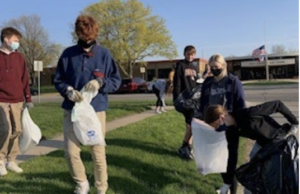Hog Confinement: State faces big questions on regulating animal waste
By Briana McGeough 2008
Whether it be the bacon at breakfast, the ham sandwich at lunch, or the pork chop at dinner, chances are good that a meal will include an Iowa grown pork product. But as 18,000 Iowa farmers raise 25 percent of the nation’s hogs, they must face the challenges this presents for the environment and principally Iowa’s water supply.
With water being essential to survival and only one percent of the Earth’s water supply being suitable for human consumption, everyone from environmentalists to politicians to farmers is concerned about water quality. The people of Iowa are no exception.
Eighty percent of Iowans get their drinking water from groundwater. This can present concerns, especially in northeast Iowa. In this corner of the state, limestone bluffs and crevices are exposed with little, if any, topsoil nearby. This is called karst topography. Water can easily penetrate these cracks and sinkholes and flow unrestrained to the stores of water resting below. Little filtering occurs as this water enters aquifers and later becomes the water that humans consume, so polluted water could also be a threat to human health.
Water quality is tested in relatively few locations. This means that if contamination occurred there could be a serious problem and experts could be unaware.
Newly appointed Director of the Iowa Department of Natural Resources Rich Leopold is concerned about Iowa’s water quality.
“My eyes are on clean water. Most areas have poor water, and that is unacceptable. Farmers and environmentalists need to work together to get something done about this,” Leopold said.
The central area of concern involving hogs and Iowa water is the manure that these hogs produce.
“Manure is contained in concrete pits. We have design standards and operation standards,” Tom McCarthy of the Iowa Department of Natural resources said.
With Iowa hogs producing 50 million tons of manure each year, farmers have their hands full with the task of keeping track of and containing all of it. As a result, occasional spills occur, and these spills can have disastrous consequences.
“The biggest impact is to the aquatic ecosystem. A large fish kill can occur, and that knocks out the food chain. Raccoons and other animals that would eat the fish struggle to find food,” McCarthy said.
Over the last four years there have been approximately 50 of these spills into Iowa streams, rivers and lakes that were serious enough for financial penalties. Overflowing manure storage lagoons have been responsible for the largest of these spills, but application of liquid manure into fields has been the cause of the most frequent spills. Although spills have been relatively infrequent, they have resulted in the death of an estimated 1.1 million fish.
In measure of volume, the largest of these spills occurred in 1995 when a malfunctioning lagoon in Webster City spilled 1.5 million gallons of manure into the Iowa River, killing almost 9,000 fish, polluting 30 miles of river and closing one of the areas primary recreational spots.
Iowa farmers generally do a good job of making an effort to prevent spills.
“Most spills are accidental. Very few are intentional, but those are the ones that are crimes. The punishment depends on the severity of the violation,” McCarthy said.
The DNR inspects hog confinements to make sure that they are up to code.
“We look at the site itself. We make sure the tile lines are operating properly and that they are taking care of dead animals. We look at their manure management plans and where the manure is going,” McCarthy said.
The frequency of inspections of a confine depends on its history.
“If they have had no problems, we inspect them every few years. If there have been some problems, we inspect more frequently,” McCarthy said.
One of the most landmark court cases in regards to hog confinement and whether it is in the state or local government’s control to regulate these confinements was the 1998 case of Goodall vs. Humboldt. The Iowa Supreme Court ruled to strike down a series of ordinances set by county government to add restrictions to livestock industry and protect groundwater. This means that the state government has almost complete control over confinement regulations.
Supporters of local control believe that decisions about the regulations of these hog confines should be left to individual communities because the people of these communities are the ones who have to deal with the odor and pollution that these confinements generate. Since the terrain and overall environment varies across the state of Iowa, local control advocates say one set of uniform laws across the state is inadequate.
Opponents of local control recognize that many communities would like to do away with hog confinements altogether. As a result, hog farmers would have fewer places where they would be allowed to raise hogs, and these farmers would have to relocate to places with a less favorable climate for raising hogs.
Hog confinement regulations are laid in two different ways: laws and rules.
“Laws are big deals. The legislature works to make them. I don’t see any changes in statues. Rules change all of the time,” Leopold said.
One of the rules that is likely to change in the near future is the regulation of applying manure to soybeans.
“The change would be about applying manure in the fall to the ground where soybeans grow. Soybeans make their own fertilizer. It would restrict how much manure could be applied to these areas,” Leopold.
According to Leopold, although this alteration in regulations could have a significant affect on water quality, most farmers should be unaffected.
“This will have little impact on most farmers. A few may have to spread their manure a little more lightly,” Leopold said.
This may, however, affect farm costs.
“It might add expense. It costs time and money to transport manure. It is a different cost to move manure five miles versus a half mile,” Leopold said.
No matter what happens in regards to the issues of hog lot regulation, local control and manure application, it is certain that the new Director of the DNR, governor and legislators will be giving pork more thought than most Iowans do when they are digging something out of their freezer in preparation for their next meal.









You must be logged in to post a comment Login